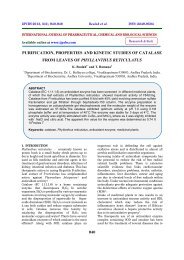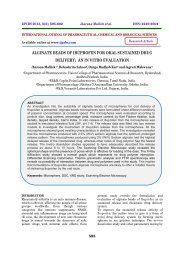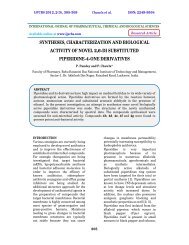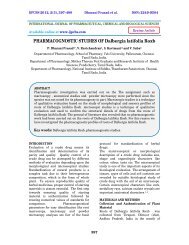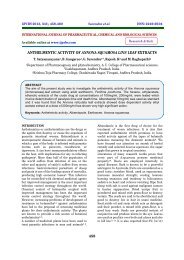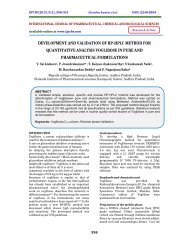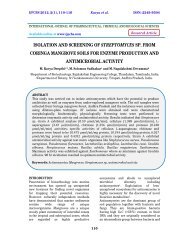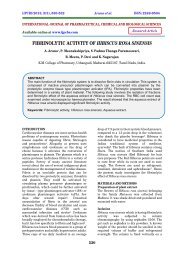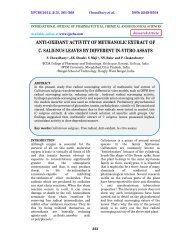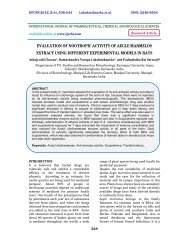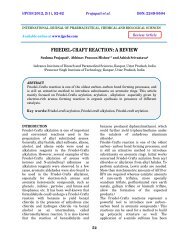antioxidant potential and free radicals scavenging activity by ... - ijpcbs
antioxidant potential and free radicals scavenging activity by ... - ijpcbs
antioxidant potential and free radicals scavenging activity by ... - ijpcbs
Create successful ePaper yourself
Turn your PDF publications into a flip-book with our unique Google optimized e-Paper software.
IJPCBS 2012, 2(4), 500-506 Mangal Sain et al. ISSN: 2249-9504<br />
INTERNATIONAL JOURNAL OF PHARMACEUTICAL, CHEMICAL AND BIOLOGICAL SCIENCES<br />
Available online at www.<strong>ijpcbs</strong>.com<br />
ANTIOXIDANT POTENTIAL AND FREE RADICALS SCAVENGING ACTIVITY<br />
BY POD EXTRACTS OF ACACIA SENEGAL WILLD<br />
Mangal Sain Hooda 1 , Rishi Pal 1, Anil Bh<strong>and</strong>ari 1 <strong>and</strong> Janardhan Singh 2<br />
INTRODUCTION<br />
Free <strong>radicals</strong> may be designated as molecular<br />
sharks that damage molecules in cell<br />
membranes, mitochondria, DNA <strong>and</strong> are very<br />
unstable, tends to rob electrons from the<br />
molecules in the immediate surroundings in<br />
order to replace their own losses 1. Reactive<br />
oxygen species (ROS) is a collective term,<br />
which includes not only the oxygen <strong>radicals</strong><br />
but also some non-radical derivatives of<br />
oxygen; these include hydrogen peroxide,<br />
hypochlorous acid <strong>and</strong> ozone 2. Numerous<br />
disorders like rheumatoid arthritis,<br />
cardiovascular disorders, cystic fibrosis,<br />
metabolic disorders, neurodegenerative<br />
diseases <strong>and</strong> gastrointestinal ulcerogenesis<br />
1Jodhpur National University, Jodhpur, Rajasthan, India.<br />
2Pt. B.D. Sharma PGIMS, Rohtak, Haryana, India.<br />
500<br />
Research Article<br />
ABSTRACT<br />
Acacia Senegal Willd (Leguminosae), known as Arabic gum tree. Its mature pods with seeds<br />
were extracted using solvents of different polarities <strong>and</strong> explored for in-vitro <strong>free</strong> radical<br />
<strong>scavenging</strong> <strong>activity</strong>. Preliminary assays of both extracts of Acacia Senegal pod scavenges 1,1diphenyl-2-picrylhydrazyl<br />
stable <strong>free</strong> <strong>radicals</strong> in concentration dependent manner. All studied<br />
extracts possess electron donating ability <strong>and</strong> reduce ferric ion to ferrous in a cell <strong>free</strong> system<br />
at pH-7.4. It has also been found from total <strong>antioxidant</strong> capacity as assessed <strong>by</strong> reduction of<br />
molybdate showed Acacia Senegal Pod-hydro alcoholic to possess when compared to<br />
st<strong>and</strong>ard ascorbic acid equivalents per milligrams of the extracts. Pod hydro alcoholic extracts<br />
were found more effective when compared to Pod water extract in <strong>scavenging</strong> 1,1-diphenyl-2<br />
picrylhydrazyl, reducing ferric ion <strong>and</strong> molybdate reduction in <strong>antioxidant</strong> capacity. The<br />
significant correlations exist between extract concentrations <strong>and</strong> percentage <strong>scavenging</strong><br />
<strong>activity</strong> of <strong>radicals</strong> in all models. Results clearly indicate that Acacia Senegal Pod is effective<br />
<strong>free</strong> radical scavenger <strong>and</strong> chain breaking <strong>antioxidant</strong>.<br />
Keywords: Acacia Senegal, Arabic gum tree, Antioxidant, Free Radical Scavenging, Kher.<br />
are reported as ROS mediated 3-4. The role<br />
played <strong>by</strong> ROS in stress induced gastric ulcer<br />
<strong>and</strong> inflammatory bowel diseases have been<br />
well established, as well as their involvement<br />
in the process of ageing 5-6. Many synthetic<br />
<strong>antioxidant</strong> components have shown toxic<br />
<strong>and</strong>/or mutagenic effects. Hence attention<br />
has been given to naturally occurring<br />
<strong>antioxidant</strong>s. Therefore, identification of<br />
effective <strong>antioxidant</strong>s <strong>and</strong> <strong>free</strong> radical<br />
scavengers from plants origin is an ideal<br />
strategy for new drug development. Hence,<br />
present study was design to explore the<br />
<strong>antioxidant</strong> <strong>and</strong> <strong>free</strong> radical <strong>scavenging</strong><br />
<strong>activity</strong> of Acacia Senegal Willd in a<br />
prospective way.
IJPCBS 2012, 2(4), 500-506 Mangal Sain et al. ISSN: 2249-9504<br />
Acacia Senegal willd (Leguminosae) also<br />
known as Arabic gum tree. Locally it is called<br />
Kumbat in Sind 7, Rajasthan <strong>and</strong> Lasbella it is<br />
called Kher 8-9, distributed mainly in tropical<br />
<strong>and</strong> sub tropical region of southern part of<br />
West Pakistan <strong>and</strong> India in Jaipur <strong>and</strong><br />
Jodhpur, the species grows to 2-15m tall with<br />
a flat or rounded crown 10. Acacia Senegal (AS)<br />
Leaves are small, grey-green, alternate cream<br />
colored flowers occur on 2-12cm long spiks,<br />
Pods are dehiscent (open <strong>by</strong> splitting at<br />
maturity) <strong>and</strong> seeds greenish-brown 11. The<br />
tree is highly valued for centuries for gum<br />
arabic production, which is used in food,<br />
Pharmaceuticals <strong>and</strong> other industries in the<br />
USA <strong>and</strong> Europe 12. Gum Arabic is approved<br />
for use as food additives <strong>by</strong> the US Food <strong>and</strong><br />
Drug Administration <strong>and</strong> in on the list of<br />
substances that are generally recognized as<br />
safe 13. Other uses include soil fertility<br />
restoration <strong>by</strong> way of atmospheric nitrogen<br />
fixation, provision of wood for fuel, local<br />
construction <strong>and</strong> poles for fence posts 14. Folk<br />
Medicine the Demulcent, emollient gum is<br />
used in inflammation of intestinal mucosa,<br />
<strong>and</strong> externally to cover inflamed surfaces, as<br />
burns <strong>and</strong> nodular Leprosy. Also said to be<br />
used for antitussive, astringent, cold coughs,<br />
diarrhea, dysentery, expectorant gonorrhea,<br />
sore throat <strong>and</strong> urinary track 15. Various<br />
chemical studies on Acacia Senegal gum<br />
contains neutral sugars (rhamnose, arabinose<br />
<strong>and</strong> galactose ), acids ( glucuronic acid <strong>and</strong> 4methoxyglucuronic<br />
acid ) calcium,<br />
magnesium, potassium <strong>and</strong> sodium 16.<br />
Phytoconstituents reported in the literature<br />
from plant AS (L.) Willd: Flavone, catechin,<br />
polyphenols, tannins, chalcones, alkaloids <strong>and</strong><br />
flavonoids 17.<br />
Various Pharmacological activities on Acacia<br />
Senegal gum exudates offers protection<br />
against cyclophosphamide induced urinary<br />
bladder cytotoxicity 18. Scavenging of nitric<br />
oxide <strong>by</strong> gum arabic has been reported to<br />
limit the acetaminophen-induced<br />
hepatotoxicity in mice 19. Other studies have<br />
documented the <strong>antioxidant</strong> properties of<br />
gum arabic in a variety of animal model<br />
system 20. The bark of AS are made into a<br />
poultice to treat bedsores <strong>and</strong> wounds. The<br />
501<br />
investigation was initiated to identify woundhealing<br />
plants <strong>and</strong> lesser known edible plant<br />
in Oman that have high <strong>antioxidant</strong><br />
capacity 17. In Present study we aimed to<br />
explore the <strong>antioxidant</strong> <strong>potential</strong> extracts of<br />
Acacia Senegal Pods. (hydro alcoholic <strong>and</strong><br />
aqueous).<br />
MATERIAL AND METHODS<br />
Chemicals Details<br />
1,1-diphenyl-2-picrylhydrazyl (DPPH), ophenanthroline,<br />
ferric chloride, ascorbic acid,<br />
<strong>and</strong> ethylene diamine tetra acetic acid (EDTA)<br />
were procured from Haryana Scientific &<br />
Engg. Corp., Rohtak. Matured pods with seeds<br />
of Acacia Senegal Willd was purchased from<br />
Jodhpur local market, Rajasthan. (India), the<br />
plant material was authenticated <strong>by</strong> Dr.<br />
Ashok Kumar Sharma, M.D. (Dravyaguna<br />
Vigyan), Prof. & Head of Department Shri<br />
Baba Mastnath Ayurvedic Degree College,<br />
Asthal Bohar, Rohtak.<br />
Extraction process<br />
Acacia Senegal shed dried plant material<br />
(matured pods with seeds) were grinded <strong>and</strong><br />
powdered material (100 g) was used for<br />
extraction. The hydro-alcoholic <strong>and</strong> aqueous<br />
extracts were prepared <strong>by</strong> hot continuous<br />
percolation method in a Soxhlet apparatus.<br />
Both extracts were collected separately <strong>and</strong><br />
dried in vacuum system. Hydro-alcoholic<br />
extract with 70% ethanol (Pod-HA, yield:<br />
12.45%) <strong>and</strong> Water extract with water (Pod-<br />
W, yield: 12.95%). Both extracts were<br />
condensed <strong>by</strong> re-distillation <strong>and</strong> dried in<br />
vacuum desiccators to obtain a final extract<br />
residue.<br />
DPPH radical <strong>scavenging</strong> <strong>activity</strong> 21<br />
The <strong>free</strong> radical <strong>scavenging</strong> <strong>activity</strong> was<br />
measured in terms of hydrogen donating or<br />
radical <strong>scavenging</strong> ability <strong>by</strong> using stable <strong>free</strong><br />
radical DPPH (100 µM) in ethanol. The equal<br />
volumes of different extracts were incubated<br />
with DPPH in graded concentrations of (10 to<br />
500 µg/ml) for 20 min. at room temperature<br />
<strong>and</strong> <strong>by</strong> using a digital UV/VIS<br />
spectrophotometer (model 371E) absorbance<br />
was recorded at 517 nm. The experiment was
IJPCBS 2012, 2(4), 500-506 Mangal Sain et al. ISSN: 2249-9504<br />
performed in triplicate. Scavenging ability<br />
was measured <strong>by</strong> decreased DPPH<br />
absorbance in test sample when compared to<br />
Percentage <strong>scavenging</strong> of <strong>free</strong> radical <strong>by</strong> test compound:<br />
502<br />
st<strong>and</strong>ard DPPH solution. Results were<br />
expressed as percentage inhibition of DPPH<br />
<strong>by</strong> comparing with blank.<br />
Absorbance of control sample- Absorbance of test sample<br />
%age Scavenging = --------------------------------------------------------------------------------------- X 100<br />
Absorbance of control sample<br />
Reduction of ferric-ions 22<br />
The electron donating capability (reducing<br />
ability) was studied <strong>by</strong> ferric chloride<br />
reduction in cell <strong>free</strong> system. The reaction<br />
mixture contained 1.0 ml of phosphate buffer<br />
(pH 7.4), 100 µM ferric chloride <strong>and</strong> 0.5 ml of<br />
test compounds of different concentrations<br />
(10-500 µg/ml). After 3 min. of incubation,<br />
EDTA (100 µM) <strong>and</strong> ortho-phenanthroline<br />
Percentage reduction of Ferric ion <strong>by</strong> test compound:<br />
(300 µM) were added, reaction was allowed<br />
for 10 min at room temperature <strong>and</strong> <strong>by</strong> using<br />
a digital UV/VIS spectrophotometer (model<br />
371E) absorbance was recorded at 510 nm.<br />
Ascorbic acid was used as st<strong>and</strong>ard as<br />
equivalent to 100% reduction of ferric ions,<br />
comparative reduction of Fe 3+ <strong>by</strong> Acacia<br />
Senegal extract was calculated.<br />
Absorbance of test sample<br />
%age Reduction = ---------------------------------------------------X 100<br />
Absorbance of ascorbic acid<br />
Total <strong>antioxidant</strong> capacity 23 [By<br />
ammonium molybdate reduction method]<br />
Total <strong>antioxidant</strong> capacity was measured in<br />
different concentrations of extract were<br />
mixed with 3ml of reagent solution<br />
(0.6Msulphuric acid, 28mMsodium phosphate<br />
<strong>and</strong> 4mM ammonium molybdate), after 90<br />
minutes incubation at 95 0C for, sample cool to<br />
room temperature <strong>and</strong> using a digital UV/VIS<br />
spectrophotometer (model 371E)<br />
absorbance of molybdate (V) formed was<br />
measured at 695 nm. The <strong>antioxidant</strong> <strong>activity</strong><br />
was expressed as the number of equivalents<br />
of ascorbic acid. Ascorbic acid was used as<br />
st<strong>and</strong>ard equivalent to 100% <strong>antioxidant</strong><br />
capacity, comparative <strong>antioxidant</strong> capacity of<br />
Acacia Senegal pod extracts were calculated.<br />
Percentage <strong>antioxidant</strong> capacity of test compound:<br />
Absorbance of test sample<br />
Percentage <strong>antioxidant</strong> capacity = --------------------------------------------------X 100<br />
Absorbance of ascorbic acid<br />
RESULTS<br />
DPPH radical <strong>scavenging</strong> <strong>activity</strong><br />
Pod extracts of Acacia Senegal scavenged the<br />
DPPH stable <strong>free</strong> <strong>radicals</strong> in a concentration<br />
dependent manner (10-500 µg/ml). Both<br />
extracts showed maximum <strong>scavenging</strong><br />
<strong>activity</strong> at 500µg/ml, effect was observed<br />
with reduced <strong>scavenging</strong> <strong>activity</strong>. The pod-HA<br />
showed maximum <strong>activity</strong> (69.91%) <strong>and</strong> pod-<br />
W (53%). In both the cases effect was
IJPCBS 2012, 2(4), 500-506 Mangal Sain et al. ISSN: 2249-9504<br />
observed at concentration 500 µg/ml. The<br />
experiment was performed in triplicate. The<br />
interaction of Acacia senegal pod-HA <strong>and</strong><br />
pod-W. extracts with DPPH <strong>radicals</strong><br />
presented in Tab. <strong>and</strong> Fig.1a.<br />
Reduction of ferric ion<br />
Reduction of ferric ion i.e. Fe 2+- Fe 3+ couple is<br />
known to be involved in various <strong>free</strong> radical<br />
reactions. Both extracts of pod-HA <strong>and</strong> pod-W<br />
reduce Fe 3+ in to Fe 2+at pH 7.4. In this study,<br />
reduction of Fe 3+ into Fe 2+ <strong>by</strong> ascorbate was<br />
taken as 100%. The pod-HA <strong>and</strong> pod-W (500<br />
µg/ml) caused a significant reduction of Fe 3+<br />
to (66.75%) <strong>and</strong> (51.36%) respectively. The<br />
experiment was performed in triplicate<br />
shown in Tab. <strong>and</strong> Fig. 1b.<br />
Total <strong>antioxidant</strong> capacity [By ammonium<br />
molybdate reduction method]<br />
The reduction of ammonium molybdate <strong>by</strong><br />
Acacia Senegal pod extracts were studied <strong>and</strong><br />
ascorbic acid was taken as 100%. It has also<br />
been found from total <strong>antioxidant</strong> capacity as<br />
assessed <strong>by</strong> reduction of molybdate showed<br />
extract of Pod- HA (600 µg/ml) extrac<br />
showed a significant reduction of molybdate<br />
to (64.77%) <strong>and</strong> the pod-W (600 µg/ml)<br />
extract showed to(40.05%). The experiment<br />
was performed in triplicate shown in Tab.<br />
<strong>and</strong> Fig. 1c.<br />
DISCUSSION<br />
Free <strong>radicals</strong> have been a subject of<br />
significant interest among scientists in the<br />
past decade <strong>and</strong> their possible role in human<br />
diseases has gained importance now in<br />
days 24-25. Antioxidants neutralize toxin <strong>and</strong><br />
volatile <strong>free</strong> <strong>radicals</strong> that are defined as atoms<br />
or groups of atoms having an unpaired<br />
electron 6. These also include related reactive<br />
oxygen species (ROS) that leads to <strong>free</strong><br />
radical generation, causes the cascading chain<br />
reaction in biological system. In a normal,<br />
503<br />
healthy organism or human body, the<br />
generation of pro-oxidants in the form of ROS<br />
is effectively kept in check <strong>by</strong> various levels of<br />
<strong>antioxidant</strong> defense. Antioxidants present in<br />
various dietary supplements offered their<br />
beneficial effects <strong>by</strong> neutralizing these ROS<br />
during various disease conditions. Lipids,<br />
proteins <strong>and</strong> DNA are all susceptible to attack<br />
<strong>by</strong> <strong>free</strong> <strong>radicals</strong> <strong>and</strong> cellular damage induced<br />
<strong>by</strong> oxidative stress has been implicated in the<br />
etiology of numerous diseases.<br />
DPPH radical is widely used as a model to<br />
investigate the <strong>scavenging</strong> <strong>potential</strong> of<br />
several natural compounds such as phenolic<br />
<strong>and</strong> anthocyanins or crude extract of plants 26.<br />
The ability of pod-HA <strong>and</strong> pod-W extracts of<br />
AS to reduce DPPH <strong>radicals</strong>, supports its <strong>free</strong><br />
radical <strong>scavenging</strong> <strong>activity</strong>. Our study<br />
indicates the proton donating property may<br />
be responsible for <strong>free</strong> radical <strong>scavenging</strong><br />
<strong>activity</strong> of AS Pod. Antioxidant compounds for<br />
example, sesamol, gallic acid poly-phenols<br />
reduce the Fe 3+ to Fe 2+ <strong>and</strong> are considered as<br />
chain breaking <strong>antioxidant</strong> for their proton<br />
donating <strong>activity</strong> 27. AS Pod reduces ferric ion<br />
at pH 7.4 which indicates its proton donating<br />
ability <strong>and</strong> supports its <strong>free</strong> radical<br />
<strong>scavenging</strong> <strong>activity</strong>. The reducing capacity of<br />
a compound may serve as a significant<br />
indicator of its <strong>potential</strong> <strong>antioxidant</strong> <strong>activity</strong>.<br />
It is also been found from total <strong>antioxidant</strong><br />
capacity as assessed <strong>by</strong> reduction of<br />
molybdate showed Pod-HA to possess when<br />
compared to st<strong>and</strong>ard ascorbic acid. It was<br />
therefore to be expected that AS pod has<br />
potent <strong>antioxidant</strong> <strong>and</strong> radical <strong>scavenging</strong><br />
ability. This <strong>activity</strong> is believed to be mainly<br />
due to their redox properties which play an<br />
important role in adsorbing <strong>and</strong> neutralizing<br />
<strong>free</strong> <strong>radicals</strong>, quenching singlet <strong>and</strong> triplet<br />
oxygen, or decomposing peroxides. Hence<br />
present study revealed <strong>antioxidant</strong> property<br />
of AS pod extracts.
IJPCBS 2012, 2(4), 500-506 Mangal Sain et al. ISSN: 2249-9504<br />
Table 1a: Interaction of Acacia Senegal a pod extracts with DPPH Radical<br />
Conc.<br />
(µg/mg)<br />
DPPH Scavenging <strong>by</strong> pod-HA DPPH Scavenging <strong>by</strong> pod-W<br />
Absorbance %Scavenging Absorbance %Scavenging<br />
500 .204±.005 69.91 .322±.003 53<br />
400 .260±.003 61.11 .352±.003 47.98<br />
200 .342±.003 49.25 .386±.003 42.90<br />
100 .403±004 40.46 .463±.006 31.50<br />
50 .520±008 23.20 .566±.001 16.50<br />
25 .599±002 13.03 .638±.008 5.90<br />
10 .632±004 6.73 650±.003 4.11<br />
Control .678±002 00.00 .678±.002 00.00<br />
a All values are mean (n = 3).<br />
Data are expressed as Mean ± S.D.<br />
Fig. 1a : Interaction of Acacia Senegal pod extracts with DPPH Radical<br />
Table 1b: Reduction of ferric ions <strong>by</strong> Acacia Senegal a pod extracts<br />
Conc.(µg/ Ferric ion reduction <strong>by</strong> pod-HA Ferric ion reduction <strong>by</strong> pod- W<br />
ml)<br />
Absorbance %Reduction Absorbance %Reduction<br />
Ascorbic<br />
acid(300µM)<br />
.406±.003 100 .405±.003 100<br />
500 .271±.002 66.75 .208±.005 51.36<br />
400 .226±.005 55.57 .190±.005 45.91<br />
200 .208±.002 51.13 .173±.004 42.52<br />
100 .156±.002 38.22 .122±.004 29.12<br />
50 .088±.004 21.47 .058±.003 14.30<br />
25 .052±.002 12.51 .021±.003 5.17<br />
10 .018±.001 4.33 .006±.001 1.42<br />
a All values are mean (n = 3).<br />
Data are expressed as Mean ± S.D.<br />
Fig. 1b: Reduction of ferric ions <strong>by</strong> Acacia Senegal pod extracts<br />
504
IJPCBS 2012, 2(4), 500-506 Mangal Sain et al. ISSN: 2249-9504<br />
Table 1c: Antioxidant capacity of Acacia Senegal a pod extracts<br />
Conc.( µg/ml) Antioxidant capacity of pod-HA Antioxidant capacity of pod- W<br />
Absorbance % Antioxidant capacity Absorbance %Antioxidant capacity<br />
Ascorbic acid<br />
(300µM)<br />
.880±.006 100 .884±.004 100<br />
600µg/.3ml .570±.005 64.77 .354±.005 40.05<br />
300µg/.3ml .297±.002 33.55 .209±.005 23.44<br />
a All values are mean (n = 3).<br />
Data are expressed as Mean ± S.D.<br />
Fig. 1c: Antioxidant capacity of Acacia Senegal pod extracts<br />
CONCLUSIONS<br />
Present study showed that hydro alcoholic<br />
pod extract of AS is most effective <strong>antioxidant</strong><br />
in various in vitro assay systems. AS has been<br />
reported to contain flavone, polyphenols,<br />
tannins, alkaloids <strong>and</strong> flavonoids 17, of these<br />
compounds, polyphenols, alkaloids <strong>and</strong><br />
flavonoids are probably responsible for its<br />
<strong>free</strong> radical <strong>and</strong> reducing property observed<br />
in this study. As compared to previous<br />
reports, our study showed that Acacia<br />
Senegal pod-HA exerted a potent effect when<br />
compared to pod-W. Further studies are<br />
required to better underst<strong>and</strong> these<br />
compounds <strong>and</strong> their effects on cellular<br />
function <strong>antioxidant</strong> properties of Acacia<br />
Senegal could be beneficial in pathological<br />
condition involving oxidative stress.<br />
REFERENCES<br />
1. Halliwell B. The w<strong>and</strong>erings of a <strong>free</strong><br />
radical. Free Radic Biol Med. 2009;<br />
46: 531-542.<br />
2. Toyokuni S. Reactive oxygen speciesinduced<br />
molecular damage <strong>and</strong> its<br />
application in pathology. Pathol. Int.<br />
1999; 49: 91-102.<br />
3. Muller FL, Lustgarten MS, Jang Y,<br />
Richardson A <strong>and</strong> Van Remmen H.<br />
505<br />
Trends in oxidative aging theories.<br />
Free Radic. Biol. Med. 2007; 43: 477-<br />
503.<br />
4. Ischiropoulos H, al-Mehdi AB <strong>and</strong><br />
Fisher AB. Reactive species in<br />
ischemic rat lung injury: contribution<br />
of peroxynitrite. Am. J. Physiol. 1995;<br />
269: L158-L164.<br />
5. McCord JM. Oxygen-derived <strong>free</strong><br />
<strong>radicals</strong> in post ischemic tissue injury.<br />
N. Engl. J. Med. 1985; 312: 159-163.<br />
6. Finkel T <strong>and</strong> Holbrook NJ. Oxidants,<br />
oxidative stress <strong>and</strong> the biology of<br />
ageing. Nature. 2000; 408: 239-247.<br />
7. Ahmed H. Kohistan of Sind. Pak.J. For.<br />
1953; 3: 51-54.<br />
8. Burkill IH. The working list of the<br />
Plants of Baluchistan. Quetta Printing<br />
press, Quetta. 1956.<br />
9. Dastur JF. Useful plants of India <strong>and</strong><br />
Pakistan, Taroporevala & Co. Ltd.<br />
Bombay. 1951.<br />
10. Maundu PM, Ngugi GW <strong>and</strong> Kasuye<br />
HC. Traditional food plants of Kenya.<br />
Nairobi, Kenya. 1999.<br />
11. Duke JA. H<strong>and</strong>book of legumes of<br />
world economic importance. Plenum<br />
Press. New York. 1981a.
IJPCBS 2012, 2(4), 500-506 Mangal Sain et al. ISSN: 2249-9504<br />
12. Anderson DMW <strong>and</strong> Weiping PW.<br />
Gum Arabic (Acacia Senegal) from<br />
Ug<strong>and</strong>a: characteristics N.M.R.<br />
Spectra, amino compositions <strong>and</strong><br />
gum/soil cationic relationships. Int.<br />
Tree Crop. J. 1992; 7(3): 169-179.<br />
13. Dondain G <strong>and</strong> Phillips GO. The<br />
regulatory journey of gum Arabic :<br />
Foods food Ingred. J. Jpn. 1999; 179:<br />
38-56.<br />
14. Fagg CW <strong>and</strong> Allison GE. Acacia<br />
Senegal <strong>and</strong> gum Arabic trade. Oxford<br />
Forestry Institute. Trop for. Papers<br />
No. 42. 2004.<br />
15. Duke JA <strong>and</strong> Wain, KK. Medicinal<br />
plants of the world. Computer index<br />
with more than 85,000 entries. 3 vols.<br />
1981.<br />
16. Leung, AY. Encyclopedia of common<br />
natural ingredients used in food,<br />
drugs, <strong>and</strong> cosmetics. John Wiley &<br />
Sons. New York. 1980.<br />
17. Majekodunmi O. Fatope , Ruchi G.<br />
Marwah, Ramla Al Mahrooqi, Gouri B.<br />
Varma, Hussain Al Abadi <strong>and</strong> Suad<br />
Khamis S. Al-Burtamani. Antioxidant<br />
capacity of some edible <strong>and</strong><br />
woundhealing plants in Oman. J. Food<br />
Chem. 2006; 465-470.<br />
18. Adel R.A. Abd-Allah, Abdulaziz A. Al-<br />
Yahya, Abdulhakeem A. Al-Majed, Ali<br />
M. Gado, Mohammad H. Daba, Othman<br />
A. Al-Shabanah <strong>and</strong> Adel S. El-Azab<br />
Acacia senegal gum exudate offers<br />
protection against cyclophosphamideinduced<br />
urinary bladder cytotoxicity.<br />
[Oxidative Medicine <strong>and</strong> Cellular<br />
Longevity. Sept. / Oct. 2009; 2(4):<br />
207-213].<br />
19. Gamal El-din AM, Mostafa AM, Al-<br />
Shabanah OA, Al-Bekairi AM <strong>and</strong> Nagi<br />
MN. Protective effect of arabic gum<br />
against acetaminophen-induced<br />
hepatotoxicity in mice. Pharmacol<br />
Res. 2003; 48: 631-365.<br />
20. Rehman KU, Codipilly CN <strong>and</strong> Wapnir<br />
RA. Modulation of small intestinal<br />
nitric oxide synthase <strong>by</strong> gum arabic.<br />
Exp Biol Med. 2004; 229: 895-901.<br />
506<br />
21. Prabhakar KR, Veerapur VP, Bansal P,<br />
Parihar VK, Reddy KM, Bhagath<br />
Kumar P, Priyadarsini KI <strong>and</strong><br />
Unnikrishnan MK. Antioxidant <strong>and</strong><br />
radioprotective effect of the active<br />
fraction of Pilea microphylla (L.)<br />
ethanolic extract. Chemico Biological<br />
Interaction. 2007; 165: 22-32.<br />
22. Parihar VK, Ganesh S, Kumar S,<br />
Mehrotra A, Reddy M, Sreedhara Pai<br />
KR, Unnikrishnan MK <strong>and</strong> Rao MC.<br />
Analgesic, anti-inflammatory <strong>and</strong> invitro<br />
<strong>antioxidant</strong> activities of<br />
Salvadora persica Linn. XXXIX Annual<br />
Conference of Indian pharmacological<br />
Society, held at NIPER Mohali<br />
Ch<strong>and</strong>igarh, November. 2007; 1-3, PP<br />
14.<br />
23. Prieto P, Pineda M <strong>and</strong> Aguilar M.<br />
Spectrophotometric quantitation of<br />
<strong>antioxidant</strong> capacity through the<br />
formation of a phosphormolybdenum<br />
complex: specific<br />
application to the determination of<br />
vitamin E, Anal. Biochem. 1999; 269:<br />
337-341.<br />
24. Maxwell SR. Prospects for the use of<br />
<strong>antioxidant</strong> therapies. Drugs. 1995;<br />
49: 345-361.<br />
25. Jovanovic SV <strong>and</strong> Simic MG.<br />
Antioxidants in nutrition. Ann. N. Y.<br />
Acad. Sci. 2000; 899:326-634.<br />
26. Veerapur VP, Prabhakar KR, Parihar<br />
VK, K<strong>and</strong>adi MR, Ramakrishana S,<br />
Mishra B, Satish Rao SB, Srinivasan<br />
KK, Priyadarsini KI <strong>and</strong> Unnikrishnan<br />
MK. Ficus racemosa stem bark extract:<br />
a potent <strong>antioxidant</strong> <strong>and</strong> a probable<br />
natural radioprotector. Evid. Based<br />
Complement Alternate Med. 2009; 6:<br />
317-324.<br />
27. Prabhakar KR, Veerapur VP, Parihar<br />
VK, Priyadarsini KI, Rao BSS <strong>and</strong><br />
Unnikrishnan MK. Evaluation <strong>and</strong><br />
optimization of radioprotective<br />
<strong>activity</strong> of Coronopus didymus Linn. in<br />
gamma-irradiated mice. Int. J. Radiat.<br />
Biol. 2006; 82: 525-536.



